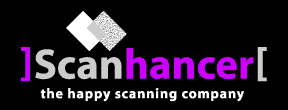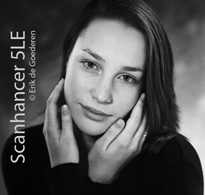

Is Scanhancer 5LE suitable for use with Black & White negative film?  Yes, the 5LE can successfully be used for B&W scanning. Results differ from film to film, mainly depending on the developer used. Films that were developed in edge sharpening developers (like Rodinal) are less helped than most others. Some films, like Kodak Tmax, are surprisingly enhanced. Yes, the 5LE can successfully be used for B&W scanning. Results differ from film to film, mainly depending on the developer used. Films that were developed in edge sharpening developers (like Rodinal) are less helped than most others. Some films, like Kodak Tmax, are surprisingly enhanced.SCANNING & PRINTING TIPS Many people wonder how to scan B&W (silver based) with the Minolta Dimage Scan Multi Pro and Scanhancer 5LE. It is strongly advised to scan as if the negative would be a slide film by choosing B&W Positive in the film type menu of the Minolta scanner driver software. Adjust the Exposure control slider so that the histogram is just within limits (on the left side). Make NO OTHER corrections in the scanner driver! (Reset Image correction.) Scan in 16bit at 4800dpi, using 2 or 4 times multi-sampling. For best edge to edge sharpness it is also strongly suggested to scan 35mm film in the MF glassholder with a mask, and use the software’s multi-format setting. In Photoshop: invert the image and adjust the grayscale to your liking by using Levels and Curves only. (Use Levels to cut away empty space in the histogram, use Curves to give the signal a nicely S-shaped curve that gives fluent gradations and good contrast.) This method helps avoiding clipped highlights or clipped shadow areas. Some practising is needed in order to get the results you want, but once you are used to it you will never give this level of control back to a scanner driver. This really is the digital darkroom! You may apply some Unsharp Masking (USM) afterwards (Amount: ±15%, Radius: 16.3, Threshold: 0 for 4800dpi files). Then downsample to the desired size using Bicubic sampling. After downsampling some new sharpening may be needed. When not needed do not make the file 8 bits, but leave at 16 bits. The B&W scans on this website are made using the method described here. For printing with an Epson Ultrachrome inkjet printer I recommend Quadtone RIP. It is highly customizable, gives excellent gradients and neutrality (no metamerism) and it is very affordable on top of all this. I have had better results from this RIP than from the 20 times more expensive ImagePrint RIP, which is normally regarded as *the* RIP to have for B&W printing. |